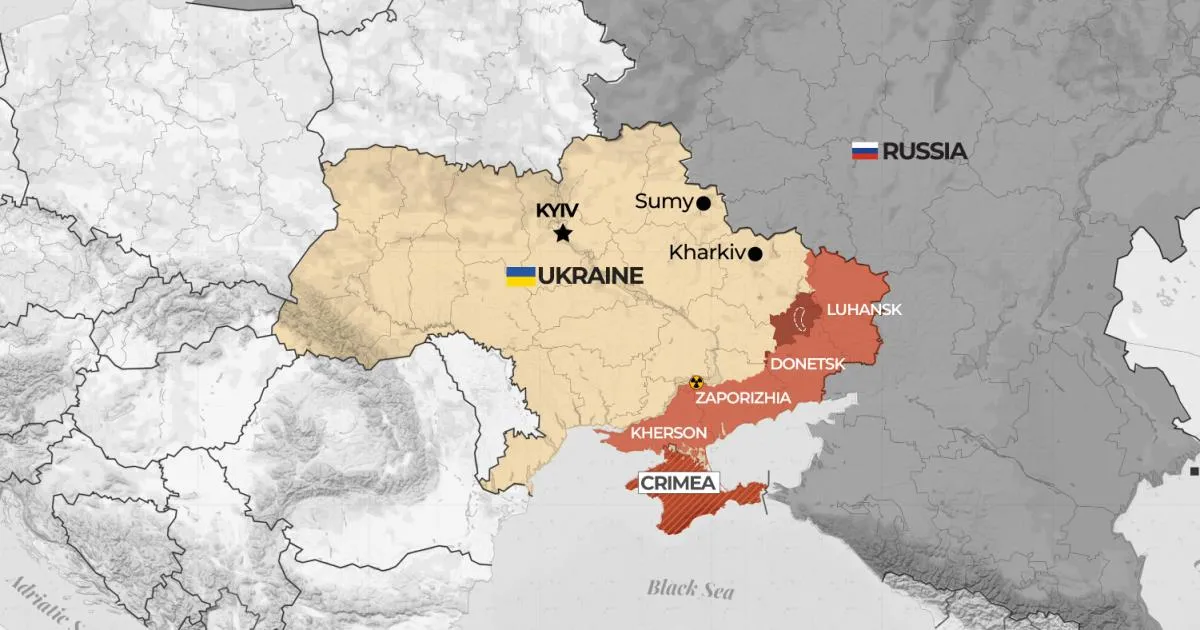
On Friday, Russian President Vladimir Putin and United States President Donald Trump are scheduled to meet in Alaska to discuss strategies aimed at ending Moscow's ongoing three-year-long war in Ukraine. This high-stakes meeting is expected to focus on a controversial proposal known as “land swapping,” indicating that Trump may be open to an agreement where Russia retains control of certain Ukrainian territories it currently occupies, albeit not all.
During a news conference at the White House earlier this week, Trump commented on the situation, stating, “Russia’s occupied a big portion of Ukraine. They occupied prime territory. We’re going to try to get some of that territory back for Ukraine.” However, the concept of land swapping raises concerns that Ukraine may have to relinquish some of the land it currently controls. Ukrainian President Volodymyr Zelenskyy has consistently opposed any deal involving the surrender of Ukrainian land to Russia, emphasizing that such an agreement would not be acceptable.
Last month, Trump issued a warning that tougher sanctions would be imposed on Russia unless it ceased its military actions in Ukraine within a 50-day timeframe. Although that deadline has passed without new sanctions against Moscow, the U.S. has imposed significant tariffs on India to penalize its continued purchase of Russian oil. Trump has insisted that Putin must agree to a ceasefire during their meeting to prevent the U.S. from imposing further tariffs on other nations engaging with Russian energy assets.
Putin’s ambitions include the complete control of Ukraine’s eastern regions, such as Luhansk, Donetsk, Zaporizhia, and Kherson, many of which were annexed by Russia in 2022, along with Crimea, which was annexed in 2014. For Kyiv to agree to any terms, it would likely require withdrawing troops from Luhansk and Donetsk, where recent fighting has been especially intense. Reports from Bloomberg indicate that U.S. and Russian officials are exploring a potential agreement that would effectively “freeze the war” while permitting Moscow to retain the territories it has captured.
The notion of Ukraine ceding any territory it has lost, both recently and back in 2014, is highly contentious. On Saturday, Zelenskyy firmly stated that he would not “gift” land to Russia, reiterating that Ukrainians would not yield their territory to Russian occupiers. Furthermore, any agreement to cede land would be illegal according to the Ukrainian constitution.
As of now, Russia occupies approximately one-fifth of Ukraine, translating to 114,500 square km (44,600 square miles). The active front line stretches about 1,000 km (620 miles) through regions including Kharkiv, Luhansk, Donetsk, Zaporizhia, and Kherson. Notably, Russia controls about three-quarters of both the Zaporizhia and Kherson regions. Additionally, smaller areas within the Kharkiv, Sumy, Mykolaiv, and Dnipropetrovsk regions remain under Russian occupation.
In the Donbas region, which consists of Luhansk and Donetsk, Russia controls around 46,570 square km (17,981 square miles), representing 88 percent of the area. While Ukraine maintains control over approximately 6,600 square km (2,550 square miles) of Donbas, Russian forces continue to concentrate their efforts on capturing the last major cities not under their control.
One significant aspect of the conflict is the so-called “fortress belt,” which extends about 50 km (31 miles) along a critical highway connecting the towns of Kostiantynivka and Sloviansk. This area includes key towns like Sloviansk, Kramatorsk, Druzhkivka, and Oleksiyevo-Druzhkivka, all of which have remained under Ukrainian control since 2014. The fortress belt has served as a pivotal obstacle to the Kremlin’s territorial ambitions over the past decade.
In August, Russian forces made notable advancements, pushing about 10 km (6 miles) beyond established front lines as they intensified efforts to capture the fortress belt. Al Jazeera’s defense editor, Alex Gatapoulos, noted, “I’m not sure what Ukraine has to offer in terms of territory. Russia has it all and is slowly winning this conflict, albeit at a great cost.” Recent movements in the east have put towns like Konstantinivka at risk of encirclement, raising concerns about the potential for catastrophic losses on the Ukrainian side.
Since the onset of the war, which began with Russia's full-scale invasion in 2022, the conflict has escalated dramatically. In the early weeks, Russia made rapid territorial gains, capturing key areas like Irpin, Bucha, and Mariupol. The siege of Mariupol was particularly devastating, with estimates of civilian deaths reaching tens of thousands. By March 2022, Russian forces had taken control of the Zaporizhzhia Nuclear Power Plant, the largest in Europe, and by April of that year, they occupied approximately 27 percent of Ukraine.
However, by late 2022, Ukraine launched successful counteroffensives in Kharkiv and Kherson, reclaiming around 54 percent of the land lost to Russia since the war began, according to data from the Institute for the Study of War (ISW). Despite these gains, the conflict has settled into a stalemate, with both sides enduring significant losses as they prepare for the next phase of the war.
Before the 2022 invasion, Russia had already annexed Crimea in 2014 and supported separatists in the Donbas region, leading to the establishment of the self-declared Donetsk and Luhansk People’s Republics. The war has triggered one of Europe’s largest displacement crises since World War II, with the United Nations estimating that around 10 million Ukrainians have been displaced—approximately 21 percent of the country’s pre-war population. Among these, 3.7 million remain internally displaced, while 6.9 million have sought refuge abroad.